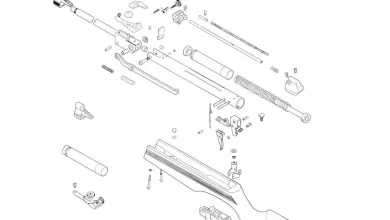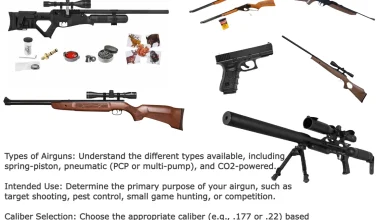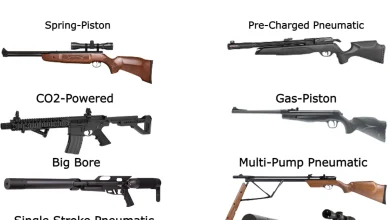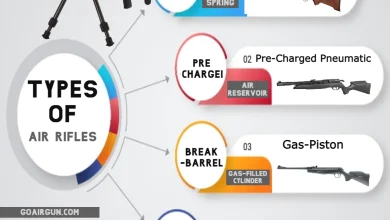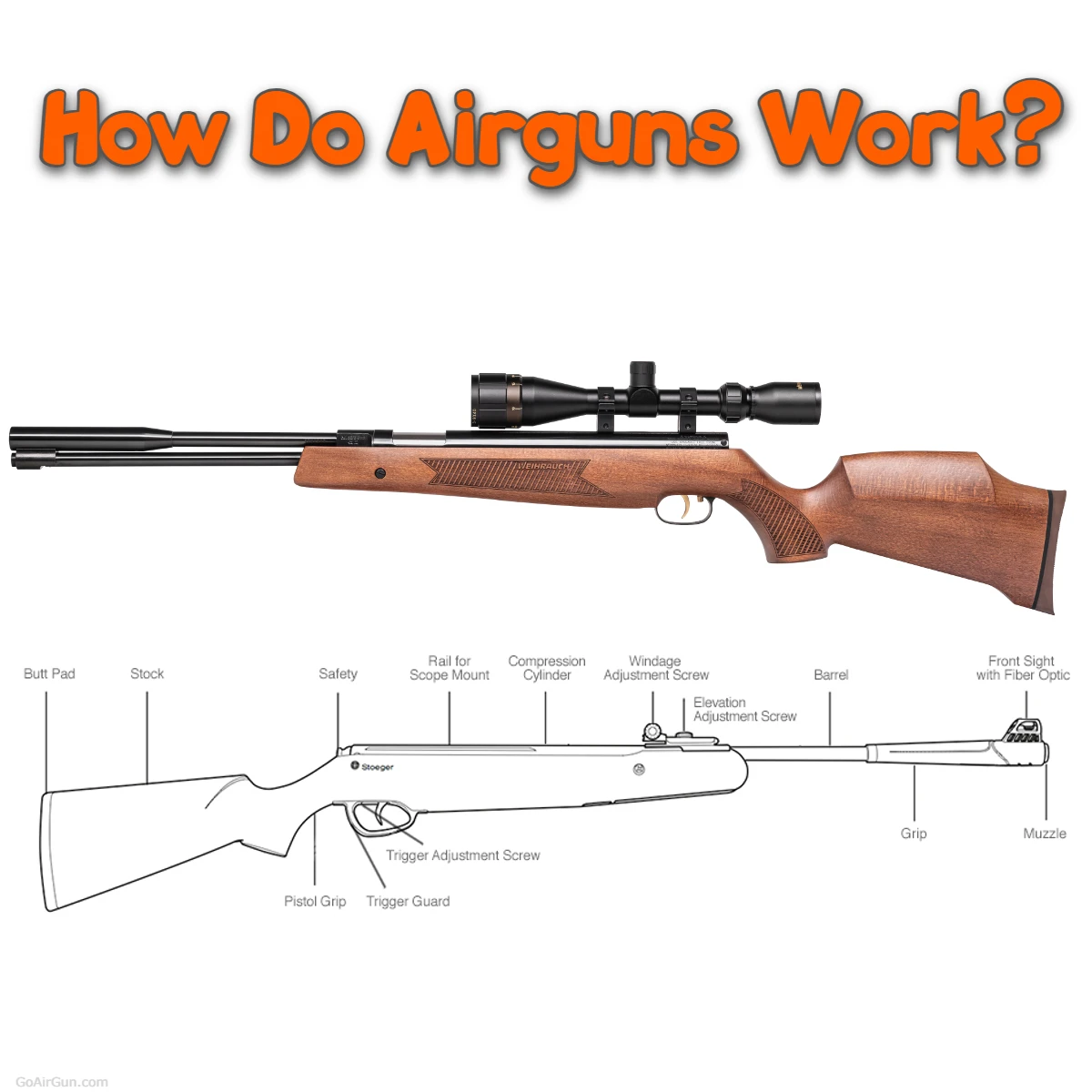
Airguns operate by utilizing compressed air as the driving force to propel projectiles with precision and power. These ingenious devices have various mechanisms, including spring-piston, pre-charged pneumatic (PCP), and CO2-powered systems. In a spring-piston airgun, manually cocking the gun compresses a spring, which, upon trigger pull, releases its energy to push a piston that compresses air, propelling the projectile.
PCP airguns, on the other hand, house a high-pressure air reservoir that, when triggered, releases controlled bursts of air to launch the projectile with exceptional accuracy. CO2-powered airguns rely on CO2 cartridges that contain pressurized gas, allowing controlled gas release upon trigger pull for projectile propulsion. Overall, airguns offer diverse shooting experiences, from the classic mechanics of springers to the precision of PCP models and the convenience of CO2-powered options.
The Essence of Airguns: How Do They Work?
At its core, an airgun is a device that propels a projectile using compressed air as its driving force. This principle of harnessing air to launch projectiles has been around for centuries, with roots dating back to early pneumatic machines. Today’s airguns, however, have evolved into highly specialized instruments, offering both recreational joy and practical applications.
The Mechanics of Power Generation
Airguns operate on a straightforward yet ingenious principle – air compression. Think of it as a controlled explosion without gunpowder. When you pull the trigger, you initiate a series of events that culminate in the release of pressurized air. This air release propels the pellet or BB (ball bearing) out of the barrel.
Here’s a simplified breakdown of the steps involved:
- Cocking or Loading: Before the shot, the gun is either cocked manually (as in a spring-piston airgun) or through a mechanism like a lever or bolt (as in a break barrel or PCP airgun). This action compresses a spring or air reservoir, storing potential energy.
- Trigger Pull: When you pull the trigger, you’re releasing the stored energy. This energy is transferred to a piston in spring-piston airguns or directly to the compressed air in other types.
- Air Release: In spring-piston airguns, the released energy pushes a piston forward, compressing air in front of it. This compressed air becomes the driving force. In pre-charged pneumatic (PCP) airguns, the trigger release allows a controlled amount of highly pressurized air to expand behind the projectile.
- Projectile Propulsion: With the sudden release of compressed air, the projectile is propelled down the barrel at impressive speeds. The barrel’s shape and length, as well as the type and weight of the projectile, influence the accuracy and trajectory of the shot.
- Recoil and Reset: Just like firearms, airguns experience recoil, albeit to a lesser degree. This recoil is a result of the forward motion of the projectile and the backward motion of the gun. After firing, the gun is reset for the next shot.
Diverse Types of Airguns: Unveiling the Choices
Airguns come in an array of types (All Type of Airguns), each with its own unique mechanisms, advantages, and limitations. Let’s take a closer look at some of the most popular categories:
Spring-Piston Airguns
Spring-piston airguns, often referred to as “springers,” are the quintessential airgun design. They embody simplicity and reliability. Within this category, you’ll find two subtypes: break barrel and underlever.
- Break Barrel: This design involves manually cocking the gun by swinging down the barrel on a hinge. This action compresses a spring, which, upon trigger pull, releases its energy to propel the projectile.
- Underlever: Unlike the break barrel, underlever airguns have a lever located under the barrel. Cocking the gun involves pivoting this lever, which again compresses a spring for firing.
Spring-piston airguns are loved for their mechanical elegance, lack of reliance on external air sources, and affordability. However, mastering the art of shooting with springers requires skill and consistency due to their unique recoil and vibration patterns.
Pre-Charged Pneumatic (PCP) Airguns
Enter the world of PCP airguns, where innovation and precision collide. PCP airguns operate using high-pressure air reservoirs, offering a consistent and powerful shooting experience. Here’s the lowdown on how they work:
- Air Reservoir: PCP airguns are equipped with a built-in air reservoir, typically filled with air using a hand pump, a scuba tank, or a specialized compressor. The air is pressurized to anywhere from 2,000 to 4,500 psi, depending on the model.
- Regulation: Some PCP models feature a regulator that ensures a consistent airflow to the pellet, resulting in a remarkably stable shot velocity. This leads to tighter shot groups, especially at longer distances.
- Trigger Mechanism: PCP triggers tend to be lighter and more adjustable than those in other airgun types. This enhances the shooter’s ability to control the shot and improve accuracy.
PCP airguns are known for their minimal recoil, quiet operation (especially when equipped with a suppressor), and exceptional accuracy. However, they require an external air source and are often pricier than other airgun types.
CO2-Powered Airguns
If you’re drawn to convenience and ease of use, CO2-powered airguns might be your cup of tea. These airguns utilize small CO2 cartridges, which eliminate the need for manual cocking or external air sources. Here’s a glimpse into their workings:
- CO2 Cartridges: CO2-powered airguns house a compartment that accommodates standard 12-gram or 88-gram CO2 cartridges. These cartridges contain pressurized CO2 gas.
- Valve System: When you pull the trigger, the gun’s valve releases a controlled amount of CO2 gas into the barrel. The expansion of CO2 propels the projectile.
- Versatility: CO2 airguns are versatile and can be semi-automatic or even fully automatic in some cases. This makes them popular for plinking, target shooting, and casual shooting sessions.
CO2-powered airguns are celebrated for their user-friendliness, lack of recoil, and ability to fire multiple shots without the need for manual cocking. However, they can be affected by temperature changes, which influence the pressure of the CO2 gas.
Here’s a comprehensive table that summarizes how different types of Airguns work:
| Airgun Type | Mechanism | Operation | Advantages | Limitations |
|---|---|---|---|---|
| Spring-Piston Airguns | Spring Compression | Cocking compresses a spring; trigger pull releases spring’s energy to push a piston that compresses air. | Mechanical elegance, no reliance on external air sources, affordability. | Requires skill to manage unique recoil and vibration patterns. |
| Pre-Charged Pneumatic | Air Reservoir and Regulation | High-pressure air reservoir stores pressurized air; regulated airflow provides consistent shot velocity. | Minimal recoil, exceptional accuracy, adjustable triggers. | Requires an external air source; higher cost compared to some other types. |
| CO2-Powered Airguns | CO2 Cartridges and Valve System | CO2 cartridges hold pressurized gas; valve releases gas to propel the projectile. | User-friendly, semi-automatic or automatic options, quiet operation. | Susceptible to temperature changes affecting CO2 pressure; fewer shots per cartridge. |
The Allure of Airguns: Why They’ve Captured Hearts
So, what’s the secret behind the enduring popularity of airguns? Let’s uncover the factors that contribute to their widespread appeal:
Accessibility and Affordability
Airguns provide an accessible entry point for shooting sports. Unlike firearms, which often require licenses and permits, airguns are legal to own and operate in many places without the bureaucratic hurdles. This accessibility extends to pricing as well. While high-end airguns can be expensive, there are budget-friendly options that still deliver enjoyable shooting experiences.
Skill Development and Precision
Shooting an airgun isn’t just about squeezing the trigger. It’s an art that demands focus, consistency, and patience. The unique characteristics of different airgun types challenge shooters to refine their techniques. This pursuit of mastery fosters a sense of accomplishment and pride. Aspiring marksmen can spend countless hours perfecting their aim, breathing control, and trigger pull.
Varied Applications
Airguns wear many hats. They’re used for competitive shooting events like field target, benchrest, and silhouette matches. They’re also excellent tools for pest control, where precision is vital to minimize suffering. Additionally, airguns cater to recreational plinkers who enjoy the satisfying ping of hitting targets. The diversity of applications ensures that there’s an airgun niche for everyone.
Reduced Noise and Recoil
For those who prefer a quieter shooting experience, airguns offer a distinct advantage. The absence of explosive gunpowder results in reduced noise, making them suitable for backyard shooting without disturbing neighbors. Additionally, the limited recoil of many airgun types promotes more comfortable and controlled shooting sessions.
Environmental Friendliness
As the world becomes more environmentally conscious, airguns step into the limelight as eco-friendly alternatives to traditional firearms. They don’t produce harmful emissions, lead pollution from spent cartridges is eliminated, and they consume less energy in their operation.
Wrapping Up the Airgun Odyssey
In the realm of shooting sports and recreational shooting, airguns have carved out their own unique identity. From the elegant mechanics of spring-piston airguns to the precision engineering of PCP models and the convenience of CO2-powered variants, each type offers a distinct experience. The accessibility, skill development, and versatility they provide have garnered a dedicated following that continues to grow.
Whether you’re a seasoned marksman or a curious beginner, exploring the world of airguns can be a thrilling journey. So, take a shot at it – you might just find yourself captivated by the precision, power, and artistry that airguns bring to the table.
FAQs
Airguns operate on the principle of harnessing compressed air to propel projectiles. Unlike firearms that use explosive gunpowder, airguns use the energy from compressed air to achieve propulsion.
In a spring-piston airgun, manually cocking the gun compresses a spring. When the trigger is pulled, the spring releases its energy, pushing a piston that compresses air in front of it. The sudden release of this compressed air propels the projectile out of the barrel.
PCP airguns have a built-in air reservoir that is filled with pressurized air. This high-pressure air is released in a controlled manner to propel the projectile. PCP airguns are known for their consistency, accuracy, and minimal recoil.
CO2-powered airguns use CO2 cartridges that contain pressurized gas. When the trigger is pulled, a valve releases a controlled amount of CO2 gas, which expands rapidly to propel the projectile. These airguns are convenient and can be semi-automatic or even fully automatic.
Airguns are often more accessible and affordable, with fewer legal restrictions. They provide an excellent platform for skill development and precision shooting. Additionally, they produce less noise, recoil, and environmental impact compared to firearms.
The main types of airguns include spring-piston airguns, PCP airguns, and CO2-powered airguns. Each type operates on different mechanisms and offers unique advantages in terms of accuracy, ease of use, and versatility.
Yes, airguns are used for hunting and pest control, especially for smaller game and pests. The accuracy and controlled power of airguns make them effective tools for ethical and humane hunting practices.
Absolutely! Airguns are widely used in various competitive shooting events like field target, benchrest, and silhouette matches. Their precision and consistency make them ideal for these disciplines.
Mastering airgun shooting requires skill and practice. Different airgun types have unique characteristics, such as recoil patterns and trigger sensitivities. Developing proper technique, including aiming, breath control, and trigger pull, is essential for accurate shooting.
For newcomers, it’s important to start with proper safety training and understanding local laws regarding airgun usage. Once you’re familiar with safety guidelines, you can explore different types of airguns, experiment with shooting techniques, and enjoy the rewarding experience of hitting targets with precision and finesse.
Read More:
